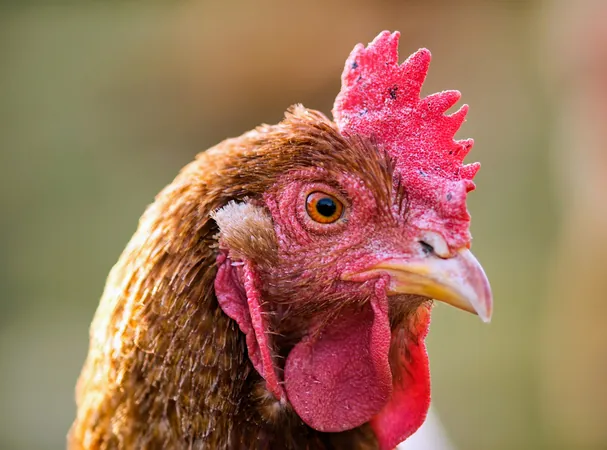
The Surprising Role of Male Hormones in Female Birds' Sexual Development Revealed!
2024-10-24
Author: Ming
The Role of Male Hormones in Avian Sexual Development
Have you ever wondered why roosters announce the dawn with their crowing while hens remain silent? This fascinating question traces back to the mid-19th century when scientist Arnold Adolph Berthold conducted an enlightening experiment by castrating a rooster. The result was profound: the rooster stopped crowing entirely.
While Berthold couldn't identify the exact factors at play, we now understand that testosterone – often referred to as the "male hormone" – is crucial for male behavior and development. This hormone isn't just for males; it plays significant roles in females as well, influencing numerous biological processes.
Understanding Testosterone and Androgens
Testosterone binds to androgen receptors to exert its effects, stimulating the production of various proteins essential for sexual development and behavior. Interestingly, testosterone can also be converted into estrogen – the well-known "female hormone" – which operates through different receptors, creating a complex network of hormonal interactions.
Birds and Their Unique Hormonal Identity
A dedicated team of researchers from the Technical University of Munich and the Max Planck Institute for Biological Intelligence, led by Benjamin Schusser and Manfred Gahr, aimed to investigate this hormonal interplay in birds. Unlike mammals, bird cells can develop sexual characteristics independently of hormonal influences, thanks to a unique avian trait known as cell autonomous sex identity. This trait suggests that birds can show surprising sexual traits that do not always align with their genetic sex.
For instance, male chickens with altered gonads still displayed classic rooster traits, prompting researchers to rethink long-standing beliefs about hormonal influence on sexual characteristics.
Innovative Research Methods
Employing cutting-edge genetic editing techniques like CRISPR-Cas, the researchers created genetically modified chickens to lack androgen receptors. This groundbreaking approach allowed them to directly observe how the absence of androgen signaling affected the birds’ development and behavior.
Chickens were chosen for this study not only because of their intelligence and social behaviors but also because they exhibit notable gender-specific actions, such as roosters crowing.
Shocking Findings with Modified Chickens
As anticipated, the modified young roosters were found to be infertile and displayed underdeveloped sexual traits, like smaller combs and wattles. Surprisingly, some traits, such as tail feathers and spurs, remained unaffected. As Mekhla Rudra, a co-lead author, pointed out, this indicates that the appearance of roosters is not solely dictated by androgen signaling.
Hens without androgen receptors exhibited infertility and smaller head ornaments, leading to a striking similarity in appearance between young roosters and hens that lack this receptor.
The Evolving Role of Testosterone
Perhaps the most surprising revelation was in adult females. Even though they continued to produce testosterone, those without androgen receptors never laid eggs or ovulated, demonstrating the androgen dependence of egg formation. This complex interplay signifies that testosterone's role in both sexes is far more intricate than previously thought, making it clear that labeling it merely as a "male hormone" is an oversimplification.
Unpacking the Complexity of Sexual Development
This study sheds light on the intricate interplay of hormone-dependent and hormone-independent mechanisms in avian sexual development. By unraveling these processes, scientists can deepen their understanding of hormonal influences across various species.
In summation, these findings reveal the importance of androgen receptor mechanisms in fertility and gender-specific traits among chickens, urging a reconsideration of established concepts around sex determination in birds.
The fascinating results of this study have been published in the journal *Nature Communications*, paving the way for future research into hormonal impacts on development and behavior in both avian species and beyond.
Stay tuned for more groundbreaking discoveries that challenge our understanding of biology and the natural world!




 Brasil (PT)
Brasil (PT)
 Canada (EN)
Canada (EN)
 Chile (ES)
Chile (ES)
 España (ES)
España (ES)
 France (FR)
France (FR)
 Hong Kong (EN)
Hong Kong (EN)
 Italia (IT)
Italia (IT)
 日本 (JA)
日本 (JA)
 Magyarország (HU)
Magyarország (HU)
 Norge (NO)
Norge (NO)
 Polska (PL)
Polska (PL)
 Schweiz (DE)
Schweiz (DE)
 Singapore (EN)
Singapore (EN)
 Sverige (SV)
Sverige (SV)
 Suomi (FI)
Suomi (FI)
 Türkiye (TR)
Türkiye (TR)